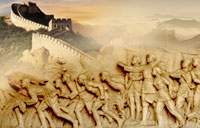Nepal scrambles to organise quake relief, many flee capital
(Agencies) Updated: 2015-04-28 09:16
 |
|
People ride on buses as traffic is affected by a landslide caused by an earthquake, in Kurintar, Nepal April 27, 2015. [Photo/Agencies] |
FLIGHT FROM KATHMANDU
Many of Kathmandu's one million residents have slept in the open since Saturday, either because their homes were flattened or they were terrified that aftershocks would bring them crashing down.
On Monday, thousands streamed out of the city. Roads leading from Kathmandu were jammed with people, some carrying babies, trying to climb onto buses or hitch rides aboard cars and trucks to the plains. Huge queues had formed at the airport.
"We are escaping," said Krishna Muktari, who runs a small grocery store in Kathmandu, standing at a road intersection.
Meanwhile, the extent of Nepal's disaster was only just emerging as reports of devastation began to come in from other parts of the country.
High in the Himalayas, hundreds of climbers were staying put at Mount Everest base camp, where a huge avalanche after the earthquake killed 17 people in the single worst disaster to hit the world's highest mountain.
Rescue teams, helped by clear weather, used helicopters to airlift scores of people stranded at higher altitudes, two at a time.
In Sindhupalchowk, about a three-hour drive northeast of Kathmandu, the death toll had reached 875 people and was expected to rise. In Dhading, close to the quake's epicentre west of Kathmandu, 241 people were killed.
Survivors spoke of trying to stay flat on the ground while the tremors shook the forested mountains. Some were stuck for hours afterwards, unable to move because of injuries.
"There is nobody helping people in the villages. People are dying where they are," said A. B. Gurung, a Nepali soldier who was waiting in Dhading district for an Indian helicopter that had gone to his village Darkha.
- PLA unit leaves for Nepal
- Nepal urgently needs tents, dry food, medicine: official
- Beijing visitors to Nepal come home
- Chinese government medical team heads to quake-hit Nepal
- Air Force planes sent to Nepal for quake relief
- S.Korea to send 40-member rescue team to quake-hit Nepal
- Death toll climbs to 3,815 in Nepal quake






